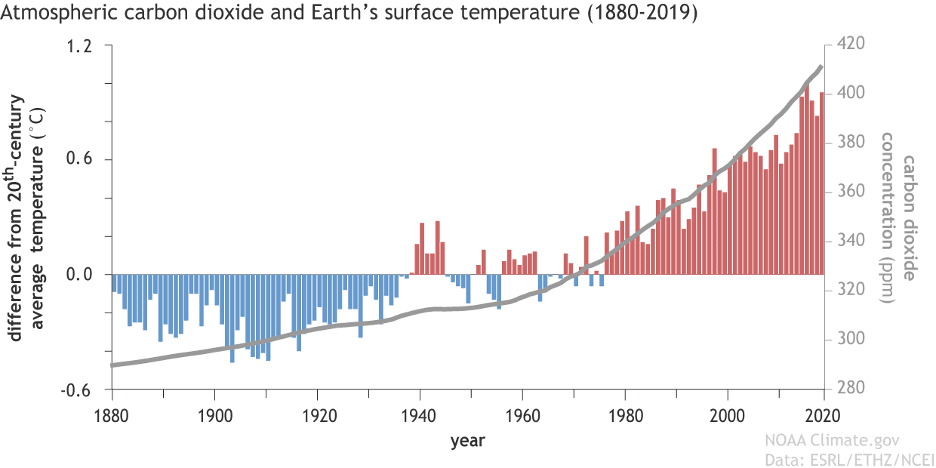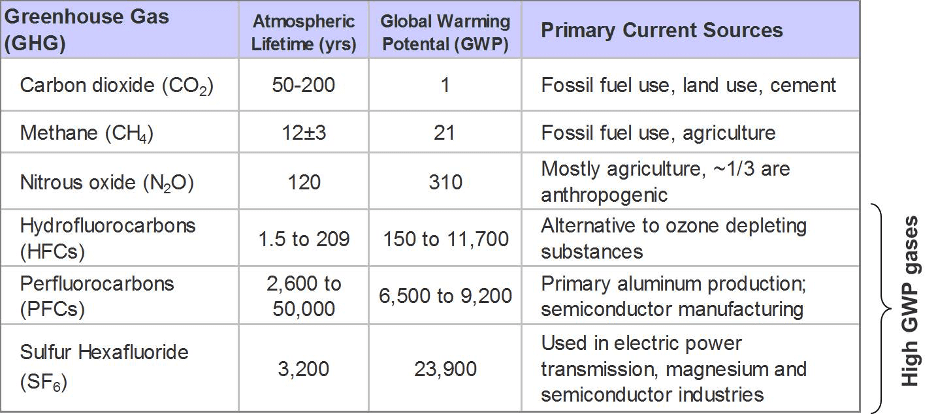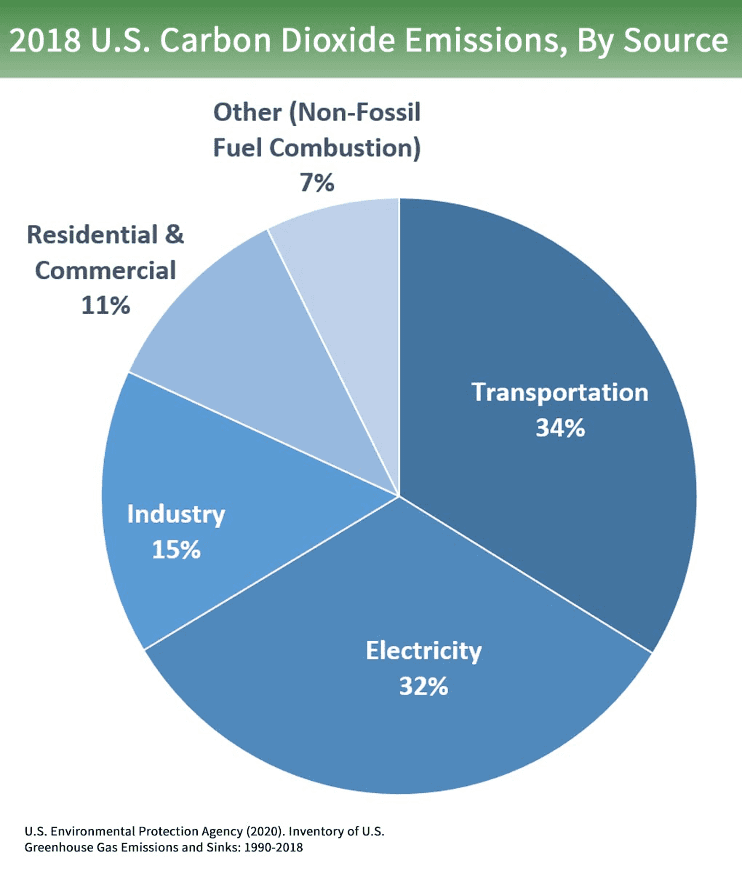The study of the role carbon plays in environmental sustainability is very complex, but fundamental to the understanding of how human activity can improve or worsen the progress of climate change. Why is carbon so pivotal in this area? This blog post will examine the role of carbon in the atmosphere, briefly discuss some of the challenges it presents, and present a variety of solutions available from the teams at Wunderlich-Malec.
The carbon molecule is present in the most prevalent greenhouse gases (GHG’s), carbon dioxide (CO2), methane (CH4), hydrofluorocarbons (HFC) and perfluorocarbons (PFC) and others in lesser amounts. In step with a growing population and increasing use of energy, the accumulation of carbon in the atmosphere is correlated with an increase in the surface temperature of the earth. The increase over time of both carbon and temperature has been rapid, as seen in the graphic below:

But not all greenhouse gases are created equal. Depending on their sources, some GHG’s accumulate and remain in the atmosphere for hundreds or thousands of years. The way we typically evaluate GHG’s is by global warming potential (GWP), which was established to allow comparison of GHG impacts. Carbon dioxide is the baseline to which all other GHG’s are measured, and the GWP is a measure of how much heat energy the gas will absorb over time, compared to the same amount of CO2. Since CO2 is the baseline, it has a GWP equal to one. As CH4 has a GWP of 21 or higher (even this is subject to debate), that means one ton of CH4 produces the same average warming as 21 tons of CO2. For that reason, some scientists characterize methane as “CO2 on steroids.” The following chart shows the GWP and average atmospheric residence time of the key GHG’s.

As the planet has continued to warm, more natural sources are emitting methane, such as the thawing permafrost in Siberia. Since the first explosion in 2014, at least 16 more craters have opened up, “like a bottle of champagne,” according to Yevgeny Chuvilin, a Moscow-based geologist. With more and more natural sources of GHG’s emitting large volumes of the gases, the need for human-caused GHG’s to be reduced becomes even more urgent, to keep the planet from warming beyond 1.5 degrees C, a threshold believed to be a tipping point for climate change.
Solutions to the challenges of reducing the volume of GHG’s going into the atmosphere and reducing what is already there will be as varied as the sources of the gases themselves. There can be no “one size fits all” solution. New technologies and advanced engineering will play a major role in reducing our use of fossil fuels and transitioning to new energy economies. As the chart below indicates, the lion’s share of CO2 emissions comes from power generation and transportation, chiefly from the burning of fossil fuels. Industry contributes roughly 15% of all GHG’s and commercial and residential buildings contribute over 10%.

Around the world, it is becoming commonplace to see not only countries and states, but many companies publicize their commitments to becoming carbon neutral, or as in the case of Microsoft, carbon “negative,” reducing their carbon footprint as measured back in time to the company’s founding. California’s Senate Bill 100 mandated a transition to “100% Clean Energy” by 2045. But it is unclear exactly how we will all get there. There is the question of how carbon footprint is measured, which we will discuss in a later post. But what methods will be implemented to achieve aggressive carbon reduction goals?
With the understanding that fossil fuels are part of the problem, we see the solutions in renewable energy sources such as wind and solar, hydroelectric power, and battery storage increasing in use. While natural gas has a smaller carbon footprint at the point of usage, the extraction of it is a major methane contributor. So, we are seeing some pressure to replace natural gas with hydrogen and ammonia in some areas. Mitsubishi-Hitachi is replacing natural gas with hydrogen in power turbines in Utah, which provide power to the Los Angeles area. Several more similar projects are being funded around the U.S. The cost of renewable energy is dropping rapidly, making the need for exploration for new fossil fuel reserves less critical.

Energy efficiency projects will remain a vital part of infrastructure improvements in the years ahead. But there must be paradigm shifts not only in energy usage, but in our own awareness of the role carbon emissions play in how we operate – on an industrial scale, and in our daily lives. As we at Wunderlich-Malec continue to evaluate the services and skillsets we provide as an engineering company, we see new paths to the future. To support our clients, we will bring new solutions to energy use, purchasing, and power generation. Examples of our current offerings include:
- mGrid™ – energy assessment and real-time modeling to optimize procurement, site power and returns, and leverage local power to manage risk
- CirrusDAHS – real-time management of continuous emissions monitoring and regulatory reporting keeps clients aware and in control of important stack emissions.
- PowerEMS – predictive emissions modeling eliminates the need for instrumentation, calibration gases, and related power usage for regulated emissions sources.
- Multi-discipline architecture and engineering (A-E) LEED® Accredited Professionals specialize in sustainable infrastructure, resilient systems, and energy and sustainability studies. Our team has designed several buildings and facilities that exceed LEED® Certification standards and we have designed several ENERGY STAR® Certified buildings, including our own office buildings.
- Mechanical and electrical engineering including advanced integration and controls, distributed generation, on-site power generation, control relay systems, medium and high-voltage protection, and more services for sustainable buildings. Innovative techniques including fuel switching, building diagnostics, asset management, energy conservation measures and other services provide optimal lifecycle operating costs for our clients.
The above is a small sample of what the Wunderlich-Malec engineers can do for our clients today. We are always innovating to bring leading-edge technologies and capabilities to our clients to help achieve operational goals.
What is next for carbon? In addition to reducing dependence on fossil fuels and implementing new fuels mixtures, technologies and new power purchasing options, we are witnessing carbon capture methods emerging in the marketplace. Wunderlich-Malec is a member of the Institute of Clean Air Companies (ICAC), and we stay informed of the latest changes in regulatory rules as well as new technologies to support them. Members of the ICAC work at the federal government level to develop pilot projects to demonstrate new, zero-carbon energy systems. They also support new technologies that capture carbon out of the atmosphere and put it to beneficial reuse or sequester it underground.
John Kelly, PE, BSEE
- Co-developer of the GBCI PEER program resources
- registered six sigma green belt
- Patent for mGrid®
- Certificate in Environmental Engineering, Illinois Institute of Technology
- Certificate in Electricity Restructuring, Illinois Institute of Technology
- Chairman of the Board for non-profit LEAN – Local Energy Aggregation Networks
Learn more:
Click here to learn more about Wunderlich-Malec’s sustainability solutions.
